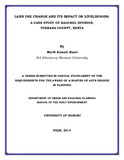| dc.contributor.author | Ewoi, Mark E | |
| dc.date.accessioned | 2014-08-04T09:17:20Z | |
| dc.date.available | 2014-08-04T09:17:20Z | |
| dc.date.issued | 2014 | |
| dc.identifier.citation | Ewoi,M.E.,2014.Land Use Change And Its Impact On Livelihoods: A Case Study Of Kalokol Division, Turkana County, Kenya,Thesis Submitted In Partial Fulfillment Of The Requirements For The Award Of A Master Of Arts Degree In Planning,department Of Urban And Regional Planning, School Of The Built Environment. | en_US |
| dc.identifier.uri | http://hdl.handle.net/11295/73587 | |
| dc.description.abstract | Land use in Turkana County has been punctuated by radical disruptions, caused by
the containment policy during and after the colonial period and recurrent droughts
coupled with intertribal conflicts during the post-Independence period. This study was
undertaken to determine the land use change that has occurred and its impact on
livelihoods in Kalokol division, in Turkana County.
The study aims were to determine the type of land use change, examine impacts of
land use change on community livelihoods, assess the resultant effect of land use
change on gender roles, determine community coping strategies of land use change
and recommend measures and strategies to minimize negative impacts of land use
change on Kalokol community livelihoods.
The study adopted a survey design and purposively selected two of the three locations
in Kalokol division which has a total population of 42,172. One sampled location is
situated on the Lake shore while the second one is about three kilometres away from
the lake shore for comparison. The data collection methods adopted by the researcher
were documents review, face to face interviews, focus group discussions, observations
and photography. The research instruments used included a semi-structured
questionnaire, an institutional and focus group discussion guide, an observation form
and a camera. Respondents from 90 households and 5 key informants were
interviewed. Two focus group discussions one for men and another for women were
held.
The findings show that the main land use changes are: declining nomadic pastoralism
and increasing permanent human settlement, fishery and business enterprises. They
depict a strong positive correlation (r= 0.989) between land use change and decline in
the major sources of livelihoods in Kalokol. The findings further indicate a significant
change in both men and women’s roles in Kalokol as a result of land use change.
Nomadic-pastoralism and basket/mat weaving are Key community coping strategies
employed for survival. Research recommends formulation of comprehensive policies
and plans by the government in conjunction with development agencies to promote,
protect and enhance pastoralism as a land use and a source of livelihoods. In addition,
the pastoral community needs to embrace diversification of livelihoods and gender
roles to enhance food security in Kalokol division. | en_US |
| dc.language.iso | en | en_US |
| dc.publisher | University Of Nairobi | en_US |
| dc.title | Land Use Change And Its Impact On Livelihoods: A Case Study Of Kalokol Division, Turkana County, Kenya | en_US |
| dc.type | Thesis | en_US |
| dc.type.material | en_US | en_US |

